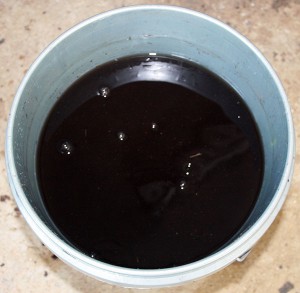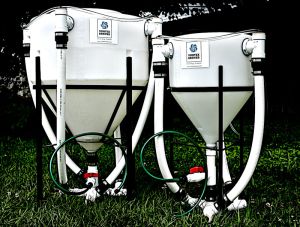A new breed of chef is blossoming. Their major recipe components involves everything from worm excrement to brewed nettles to fungus swimming in molasses. Their kitchen gadgets include buckets, air stones, and even pantyhose. There are no walls, and their most demanding clientele include the finicky tomato and the gregarious squash. This culinary mastermind is known as the compost tea chef, and anyone who wants to pamper their plants can obtain this lofty status.
Over the years, many recipes for compost teas have sprung up at farms and gardens around the world. The simplest includes dumping manure in a tied up burlap sack and immersing in a bucket of water for several days. More complicated methods include vortex brewers that mimic the method of creating biodynamic tea.


The new popular method involves aerated teas. It’s burgeoning fame is obvious due to its effectiveness, and its ease on the wallet (sans the vortex brewer). The two basic ingredients before starting the aeration includes a good compost/and or worm castings-which contain numerous beneficial microbes-and a sugar based source like molasses to feed the microbes. Other additions include alfalfa meal, corn meal (a natural fungicide), fish meal (another microbe feeder), and even apple cider vinegar which can increase the shelf life of the tea.

Also, aerated (or brewed) teas have advantages over non-aerated (i.e. the manure tea mentioned above) for numerous reasons:
1) Beneficial microbes breed better in the tea through better oxygen distribution, which in turn creates larger populations of beneficial bacterias and fungi. Also, beneficial fungi is specifically aerobic (aka oxygen fed), which means its populations are not as dense in non-oxygenated teas.
2) Aerated teas are proven more effective in combating disease as well as providing nutrients to the plant through either a soil drench or a foliar feed.
3) These aerobic (aka oxygen fed) microbes produced in the tea can reduce the smell of compost piles, teas, and the garden.
4) A good aerated tea costs pennies. Five gallons (diluted) can be used as a foliar spray on an entire acre of garden. A soil drench will take 15 gallons of tea for an acre. Furthermore, the amount of beneficial microbes in a 5 gallon batch of aerated tea is the equal to about 10 tons of regular compost.
5) Spring and summer gardens demand large populations of beneficials to offset bad microbes. Aerated teas meet this criteria.
Basically, all the equipment you need is a five gallon bucket (optimally black), a one valve air pump, a large air stone, and 1/4″ vinyl tubing.
The recipe we use is from our Fifth Season stores, courtesy of Anna Haupt at the Charlottesville location:
Step-by-step
- Fill 5 gallon bucket almost full with water (approx 4-4.5 gallons)
- Insert air stone(s) and plug in pump.
- Add 1-2 cups worm castings, compost, etc. along with equal parts sugar source such as molasses, molasses-based organic liquid fertilizer, etc. For easier straining in the end, you can put the castings in a panty hose or laundry bag before beginning the aeration.
- Wait 24 hours (or until healthy ‘krausen’, biologically active foam, forms on top of surface)
- Use compost tea immediately for best results, or store refrigerated for up to 10 days.* Tea should be diluted with water for use as a foliar spray or soil drench. Rates will vary based on needs of plants. Oftentimes, 1 cup compost tea to 1 gallon water is all that is needed for beneficial results.

Dale says
Hi
What does cider vinegar do in a fish molasses emulsion? Does it speed up the process to make the end fertiliser quicker?
ashley says
Hi Dale,
I think that lowering the pH with the vinegar would create a more shelf-stable product, similar to canning when the pH needs to hit a specific target. — Mike at Fifth Season Gardening